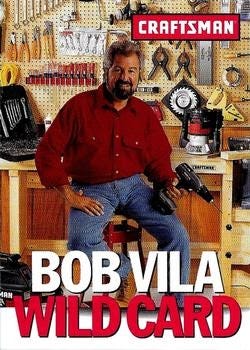Mark Slavonia (MJS) is an investor, a pilot, and an avid cyclist. He wrote about kitchen ballet, Bike Everesting, Rowing Machines, and Traveler’s Checks. He posts other things that are interesting on his website and on Twitter.
Mark here. In the 1980s, there wasn’t a lot on TV. One of public television’s biggest hits at the time was This Old House, the grandfather of the home remodeling genre. The show premiered in 1979 on WGBH Boston and featured a slow pace (a 13 episode season followed a single home remodeling project), low stress, and an amiable host, Bob Vila, along with a recurring cast of tradespeople, including Norm the carpenter. It was so popular that it was spoofed on Saturday Night Live and inspired the long-running sitcom “Home Improvement.”
Norm Abram and Bob Vila on This Old House (photo: WGBH)
Then in 1989, at the peak of the show’s popularity, This Old House and Bob Vila shocked their fans and parted ways. WGBH announced that they had not renewed Vila’s contract for the following season. Money was at the root of the split—Vila had signed personal endorsement deals while the PBS show was avowedly non-commercial.
Why Is This Interesting?
This simple explanation masks complicated questions about commercialization, credibility, and celebrity—questions that we’re still wrestling with today. Who is bigger: the star or the show? Who has the right to cash in? Can audiences assume that programs and hosts offer unbiased advice?
Bob Vila wanted to be an ambassador, a home improvement influencer before the concept was well developed. A reality TV show developed today, even on public television, would contemplate the potential value and conflicts that fame and exposure could create for the cast and the creators. At the time, WGBH and Vila were well-intentioned but unprepared for the questions that they faced.
This Old House wasn’t free from commercial sponsors, and Vila wasn’t unreasonably greedy. In the ‘80s, This Old House was popular but neither high budget nor lucrative. In his first contract, Vila was paid $250 per episode to make the show, and his last contract paid him $800/episode ($20,800 for the 26-episode season, about $45,000 in 2021 dollars) at a time when he was a household name synonymous with home improvement.
The show’s producers initially had no objection to Vila’s outside endorsement deals until they began to create problems for the show’s ability to raise money from “underwriters”—essentially, exclusive advertisers who were permitted a low-key, classy promotional ad at the beginning and the end of PBS’s highbrow content. Underwriters provided WGBH with about $1 mm per year for the show, and Vila’s endorsements had reached about $250,000. The largest underwriter was an up-and-coming home improvement chain called Home Depot, which specifically objected to Vila’s contract with Rickel DIY Centers.
This wasn’t the first time public television had launched outsized celebrities. Two decades earlier, the same station, WGBH Boston, and the same director, Bob Moresh, presented The French Chef with Julia Child. Jim Henson parlayed the fame he earned from Sesame Street to create for-profit works featuring the Muppets. But neither of these stars directly challenged the genteel but somewhat hypocritical non-commercialization of PBS the way that Vila did. In a 2009 interview with Boston Magazine, This Old House’s carpenter, Norm Abram, made the contrast explicit. “I look at Julia Child. There’s a woman who never endorsed anything. The last thing I ever want to be is a pitch-man. I don’t want to be running around the country pitching tools or doing infomercials. That’s for somebody else.”
In a way, everyone involved got what they wanted. This Old House continued on with a new host. Vila launched a rival program, cheekily called Bob Vila’s Home Again. That same year Vila signed a $5 million endorsement deal with Sears for Craftsman tools. But the show, and Vila, never reached the same height of popularity and cultural relevance. Copycat programs proliferated. HGTV, a channel exclusively devoted to home improvement, was launched in 1994. Vila and This Old House were facing a showdown over which was bigger—the show or the host—but both emerged diminished. If Vila and This Old House had found a way to continue to work together in 1989, they might have created a more powerful home improvement entertainment empire.
Bob Vila in an advertisement for Sears
In the end, This Old House couldn’t escape the pressures of commercialization. WGBH sold the show to Time Inc. in 2001, thus ending its not-for-profit status and plunging the show into the whirlpool of media mergers and acquisitions. Most recently, in March 2021, the streaming service Roku bought This Old House Ventures for $98 million, making 1,500 episodes of This Old House-related programs available to its streaming subscribers. The Home Depot now operates over 2,000 superstores worldwide and sells over $100 billion of home improvement products annually. Rickel Home Centers filed for bankruptcy and liquidation in 1996. Culture, as always, kept moving, and what feels today like a naive decision only looks that way with the benefit of thirty years of hindsight. (MJS)
Quick Links:
The Darker Story Just Outside the Lens of Framing Britney Spears (NRB)
Google delays Chrome's cookie-blocking privacy plan by nearly 2 years (NRB)
You Won’t Have Andy Richter to Sidekick Around Anymore (NRB)
[Sponsored Link] If you’re at a SaaS company, check out Variance. It’s a tool to help grow customers (some people are calling it a PLG CRM). If you have questions or want to try it, get in touch. (NRB)
Thanks for reading,
Noah (NRB) & Colin (CJN) & Mark (MJS)
—
Why is this interesting? is a daily email from Noah Brier & Colin Nagy (and friends!) about interesting things. If you’ve enjoyed this edition, please consider forwarding it to a friend. If you’re reading it for the first time, consider subscribing (it’s free!).




